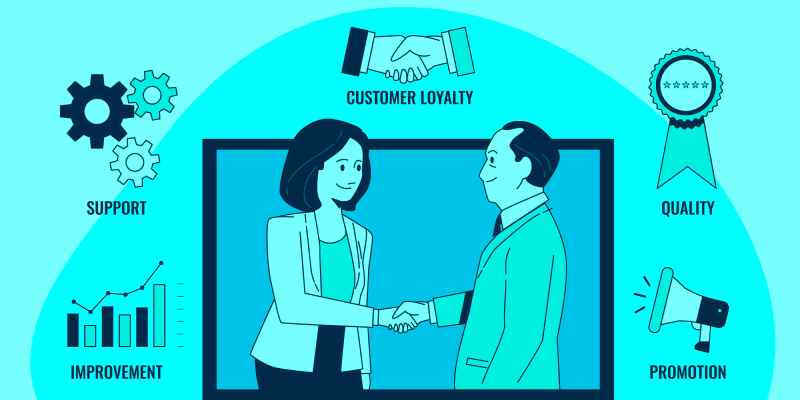Customer Success vs. Sales: Differences and Similarities

Understanding the differences between customer success and sales in SaaS is crucial for navigating the intricacies of customer retention, satisfaction, and acquisition.
Although both departments participate equally to ensure and maintain the business’ sustainability and growth, they work with different methodologies and goals. While customer success focuses on ensuring customers derive maximum value from the SaaS platform, the sales team is mainly responsible for acquiring new customers and ensuring revenue growth through transactions.
In the following article, we will cover what you need to know about both sales and customer success, from their definitions to similarities and differences. Most importantly, we will explain how to create a harmonious relationship between these two teams, which is the ultimate goal for any SaaS company.
Customer Success and Sales: Definitions
There is a great possibility you’ve heard the question or even asked yourself, “Is customer success sales? The first step towards establishing successful sales and customer success strategies is understanding their distinctive definitions.
Customer success’s prime goal is to ensure customers achieve their objectives while using a given SaaS software. Customer success teams remain actively involved with customers throughout their entire lifecycle to provide proactive support, understand their unique needs, and help them achieve value realization (that “AHA moment”) as quickly as possible. To fully understand why customer success is crucial, you need to comprehend the main objectives — maximizing customer retention, customer satisfaction, and lifetime value. By implementing efficient strategies that drive product adoption and usage, customer success managers foster long-term relationships with customers.
On the other hand, the sales team is responsible for identifying potential customers and closing deals with them to ensure the company has a stable revenue stream. In other words, the sales department is focused on customer acquisition. The sales team’s primary goals are presenting the company’s offerings as the best possible solution for prospects, negotiating contracts to close deals, and driving revenue through successful transactions.

Customer Success vs. Sales: Similarities
Now that we have covered the definition of both teams, let’s see the similarities between sales and customer success.
Both departments aim to build relationships with customers. Customer success teams do this through ongoing engagement, personalized interactions, and support, while sales teams communicate effectively and offer solutions through the products they sell.
Generating revenue counts as a responsibility of both departments. Although customer success focuses on boosting retention and lifetime value and sales on acquiring new customers, the ultimate goal is to drive as much revenue as possible.
Leveraging testimonials and success stories is crucial for both functions. The sales department builds credibility and addresses objections during the sales procedure by presenting customers with the specified information. On the other hand, customer success highlights the given customer satisfaction proofs to reinforce the advantages of the SaaS solution.
Finally, efficient collaboration between customer success and sales is paramount for ensuring an impeccable and seamless customer experience. By sharing insights, working on account strategies, and coordinating efforts to boost customer satisfaction, these two departments complement each other and drive revenue growth.
Customer Success vs. Sales: Differences
As we mentioned before, the main difference is their unique objectives (customer success: ensuring product adoption and boosting lifetime value; sales: customer acquisition). Besides that, their focus areas differ as well.
Customer success focuses on the post-sales phase like onboarding, support, education, and training, while sales teams engage in lead generation, negotiation, and closing deals. Therefore, sales focus on building transactional relationships by establishing initial trust and credibility with the prospects, and customer success builds long-term relationships by providing ongoing guidance and support through the customer journey.
Their metrics also differ. Customer success metrics include customer retention rate, customer satisfaction scores, churn rate, expansion revenue, customer health scores, etc. Sales metrics encompass new customer acquisition rates, conversion rates, revenue generated from accounts, etc. In the first case, the metrics are focused on customer satisfaction and retention, while in the second one, the metrics show transactional and revenue data that measures the success of the sales efforts.
Should Customer Success and Sales Work Side by Side?
The short answer to the given question would be “Yes!” But let’s elaborate.
First, incorporating customer success into the sales approach emphasizes retention and long-term satisfaction. By understanding the unique customer needs and challenges of potential customers (which the customer success teams do for existing customers), the sales team can promote the product better and uncover how it can address specific customer needs.
Also, customer success aims to establish transparent and trustful relationships with clients, and if the sales professionals do the same at the very beginning, there’s a greater possibility of closing the deal.
One of the surest and easiest ways to get in-depth knowledge of your customer base is to get relevant data on their activities, interactions, and behavior. This is precisely where customer success platform Akita can help you with its high-edge segmentation options, automated triggers for at-risk accounts, health scores for each profile, visualized data, and more.
Now, to answer a frequently asked question, “What is a CSM in sales?” let’s give you an example of how they collaborate. Although a customer success manager (CSM) focuses on retaining existing customers rather than acquiring new ones, it’s highly beneficial for a SaaS business if a CSM collaborates with the sales department during onboarding. This is a good way to ensure a seamless handoff from the sales process to post-sales onboarding and help the customer success teams get insight into customer needs, address customer concerns, and tailor a personalized onboarding experience for everyone.
Finally, when both teams collaborate effectively, they can align their efforts to prioritize customer retention, satisfaction, and expansion opportunities, which all lead to mutual success and desired revenue growth.
Customer Success vs. Sales — Conclusion
Although customer success and sales teams have different functions within a SaaS company, they are undoubtedly interconnected and essential for fostering customer satisfaction and driving sustainable growth.
While customer success is focused on ensuring the long-term satisfaction of existing customers, the sales team aims to attract new prospects and close as many deals as possible.
Still, their common objective is to maximize customer lifetime value and foster customer satisfaction to boost both customer retention and acquisition goals. Find the right customer success platform, so you can learn more about your customer base and never miss a chance to provide a personalized experience to each and every customer!
Frequently Asked Questions
How is customer success different from sales?
Customer success aims to nurture and retain customer relationships, while the sales department focuses on acquiring new customers.
Can you move from customer success to sales?
Sure, you can! You’ve probably honed your communication skills through customer interaction, which is also crucial in sales. This is a good start! Also, having an in-depth knowledge of the product you wish to sell is essential, and CSM managers always make sure to have one. Still, seeking help from sales professionals within your company will surely help you learn the craft much faster.
Does customer success sit under sales?
They usually operate under different leadership and objectives, as their focuses and responsibilities within the company differ.








